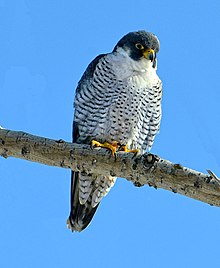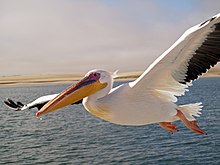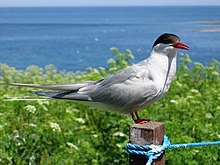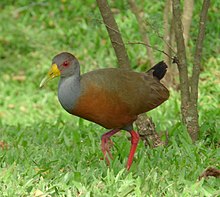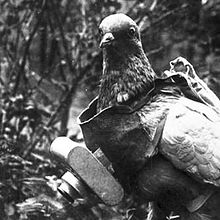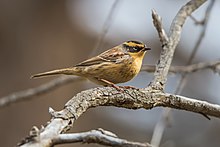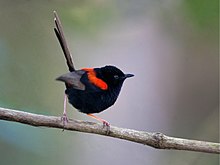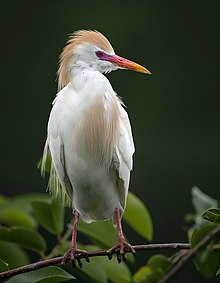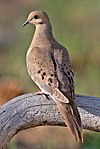Portal:Birds
The Birds Portal

Birds are a group of warm-blooded vertebrates constituting the class Aves (/ˈeɪviːz/), characterised by feathers, toothless beaked jaws, the laying of hard-shelled eggs, a high metabolic rate, a four-chambered heart, and a strong yet lightweight skeleton. Birds live worldwide and range in size from the 5.5 cm (2.2 in) bee hummingbird to the 2.8 m (9 ft 2 in) common ostrich. There are over 11,000 living species, more than half of which are passerine, or "perching" birds. Birds have wings whose development varies according to species; the only known groups without wings are the extinct moa and elephant birds. Wings, which are modified forelimbs, gave birds the ability to fly, although further evolution has led to the loss of flight in some birds, including ratites, penguins, and diverse endemic island species. The digestive and respiratory systems of birds are also uniquely adapted for flight. Some bird species of aquatic environments, particularly seabirds and some waterbirds, have further evolved for swimming. The study of birds is called ornithology.
Birds are feathered theropod dinosaurs and constitute the only known living dinosaurs. Likewise, birds are considered reptiles in the modern cladistic sense of the term, and their closest living relatives are the crocodilians. Birds are descendants of the primitive avialans (whose members include Archaeopteryx) which first appeared during the Late Jurassic. According to recent estimates, modern birds (Neornithes) evolved in the Late Cretaceous and diversified dramatically around the time of the Cretaceous–Paleogene extinction event 66 million years ago, which killed off the pterosaurs and all non-avian dinosaurs.
Many social species pass on knowledge across generations, which is considered a form of culture. Birds are social, communicating with visual signals, calls, and songs, and participating in such behaviours as cooperative breeding and hunting, flocking, and mobbing of predators. The vast majority of bird species are socially (but not necessarily sexually) monogamous, usually for one breeding season at a time, sometimes for years, and rarely for life. Other species have breeding systems that are polygynous (one male with many females) or, rarely, polyandrous (one female with many males). Birds produce offspring by laying eggs which are fertilised through sexual reproduction. They are usually laid in a nest and incubated by the parents. Most birds have an extended period of parental care after hatching.
Many species of birds are economically important as food for human consumption and raw material in manufacturing, with domesticated and undomesticated birds being important sources of eggs, meat, and feathers. Songbirds, parrots, and other species are popular as pets. Guano (bird excrement) is harvested for use as a fertiliser. Birds figure throughout human culture. About 120 to 130 species have become extinct due to human activity since the 17th century, and hundreds more before then. Human activity threatens about 1,200 bird species with extinction, though efforts are underway to protect them. Recreational birdwatching is an important part of the ecotourism industry. (Full article...)
Featured articles
Selected general bird topic
Selected taxon
The silky-flycatchers are a small family, Ptiliogonatidae, of passerine birds. The family contains only four species in three genera. They were formerly lumped with waxwings and hypocolius in the family Bombycillidae, and they are listed in that family by the Sibley-Monroe checklist. The family is named for their silky plumage and their aerial flycatching techniques, although they are unrelated to the Old World flycatchers (Muscicapidae) and the tyrant flycatchers (Tyrannidae).
They occur mainly in Central America from Panama to Mexico, with one species, the phainopepla, extending northwards into the southwestern US. Most do not engage in long-distance migration (instead wandering widely in search of fruit), but the phainopepla is migratory over the northern part of its range.
They are related to waxwings, and like that group have soft silky plumage, usually gray or pale yellow in color. All species, with the exception of the black-and-yellow phainoptila, have small crests. They range in size from 18 to 25 cm in length and are mostly slender birds (with the exception again of the black-and-yellow phainoptila). All the species in this family are sexually dimorphic in both plumage color and tail length. Juveniles of both sexes are colored like the female. (Full article...)Topics
Anatomy: Anatomy • Skeleton • Flight • Eggs • Feathers • Plumage
Evolution and extinction: Evolution • Archaeopteryx • Hybridisation • Late Quaternary prehistoric birds • Fossils • Taxonomy • Extinction
Behaviour: Singing • Intelligence • Migration • Reproduction • Nesting • Incubation • Brood parasites
Bird orders: Struthioniformes • Tinamiformes • Anseriformes • Accipitriformes • Galliformes • Gaviiformes • Podicipediformes • Procellariiformes • Sphenisciformes • Pelecaniformes • Ciconiiformes • Phoenicopteriformes • Falconiformes • Gruiformes • Charadriiformes • Pteroclidiformes • Columbiformes • Psittaciformes • Cuculiformes • Strigiformes • Caprimulgiformes • Apodiformes • Coraciiformes • Piciformes • Trogoniformes • Coliiformes • Passeriformes
Bird lists: Families and orders • Lists by region
Birds and humans: Ringing • Ornithology • Bird collections • Birdwatching • Birdfeeding • Conservation • Aviculture
Quotes
| “ | The moment a bird was dead, no matter how beautiful it had been when in life, the pleasure arising from the possession of it became blunted... | ” |
Resources
Free online resources:
- SORA: The Searchable Online Research Archive (SORA) has decades worth of archives of the following journals: The Auk, The Condor, Journal of Field Ornithology, North American Bird Bander, Studies in Avian Biology, Pacific Coast Avifauna, and The Wilson Bulletin. Coverage ends around 2000. The ability to search all journals or browse exists on the front page.
- Notornis: The Journal of the Ornithological Society of New Zealand covers New Zealand and the South Pacific.
- New Zealand Journal of Ecology: This journal often publishes bird-related articles. Like Notornis, this journal is concerned with New Zealand and surrounding areas.
- Marine Ornithology: Published by the numerous seabird research groups, Marine Ornithology is specific and goes back many years.
- BirdLife International: The Data Zone has species accounts for every species, although threatened species and some key groups have greater detail with others only having status and evaluation.
- Author Index: This is a good source for binomial authorities for taxoboxes.
There is also Birds of North America, Cornell University's massive project collecting information on every breeding bird in the ABA area. It is available for US$40 a year.
For more sources, including printed sources, see WikiProject Birds.
WikiProjects
Selected images
Selected bird anatomy topic
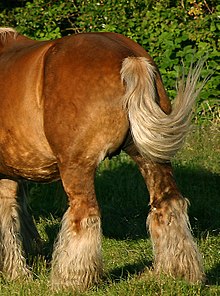
The rump or croup, in the external morphology of an animal, is the portion of the posterior dorsum – that is, posterior to the loins and anterior to the tail. Anatomically, the rump corresponds to the sacrum.
The tailhead or dock is the beginning of the tail, where the tail joins the rump. It is known also as the base or root of the tail, and corresponds to the human sacrococcygeal symphysis. In some mammals the tail may be said to consist of the tailbone (meaning the bony column, muscles, and skin) and the skirt (meaning the long hairs growing from the tailbone). In birds, similarly, the tail consists of tailbone and tailfan (tail fan). (Full article...)Selected species
Mourning doves are light grey and brown and generally muted in color. Males and females are similar in appearance. The species is generally monogamous, with two squabs (young) per brood. Both parents care for the young for a time. The species is a prolific breeder, and pairs will often have several broods per year. In warm areas, a pair may have up to six broods a year. Mourning doves eat mainly seeds, including those of both native and introduced plants.
Did you know
- ...that the hood mockingbird will occasionally attack people in an attempt to get fresh water from them?
- ...that prior to the development of binoculars, bird collections, collections consisting of birds and parts of their anatomy, were the dominant method of bird observation and study among ornithologists?
- ...that bird nests range in size from the tiny one inch high cup of some hummingbirds to the massive five meter high mounds of some dusky scrubfowl?
Categories
Related portals
Things you can do
Create requested articles (WikiProject Birds – Article requests):
Do these tasks:
 |
Here are some tasks awaiting attention:
|
More outstanding tasks at the project's cleanup listing, Category:Birds articles needing attention, and Wikipedia:WikiProject Birds/Todo.
Taxonomy of Aves
| Class Aves, divided into superorders, orders, suborders (where indicated), and families. | ||||
|---|---|---|---|---|
|
Associated Wikimedia
The following Wikimedia Foundation sister projects provide more on this subject:
-
Commons
Free media repository -
Wikibooks
Free textbooks and manuals -
Wikidata
Free knowledge base -
Wikinews
Free-content news -
Wikiquote
Collection of quotations -
Wikisource
Free-content library -
Wikispecies
Directory of species -
Wikiversity
Free learning tools -
Wikivoyage
Free travel guide -
Wiktionary
Dictionary and thesaurus
Sources
- ^ Mead, D., ed. (1848). The American Literary Emporium. New York, NY, US: C. H. Camp. p. 209.




